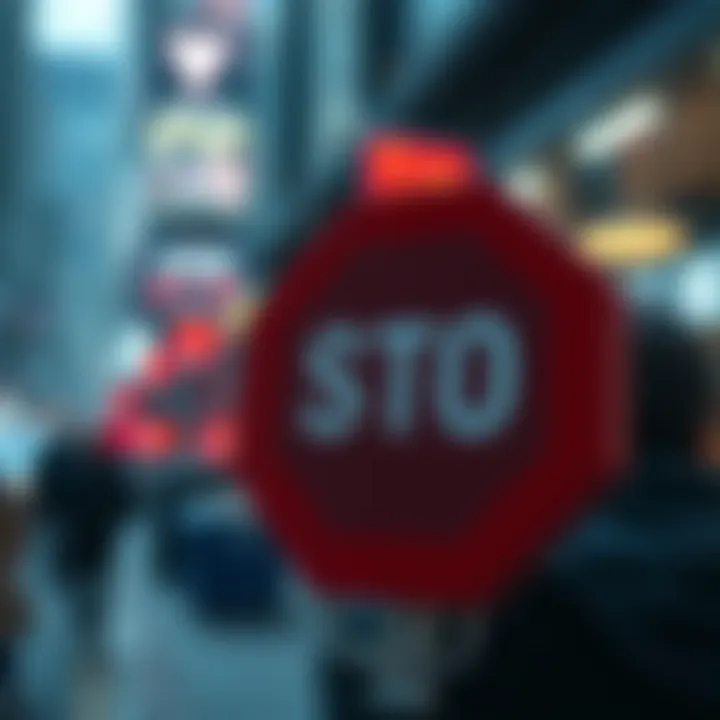Understanding Stop Limit Orders: A Comprehensive Guide


Investment Dictionaries
Investing can feel like navigating a jungle filled with jargon and terminology that might leave newcomers scratching their heads. One essential ingredient in creating a solid foundation for any investor is a clear understanding of key financial terms. Here, we’ll break down a few concepts that are crucial when dealing with stop limit orders.
Key Financial Terms
- Stop Limit Order: A type of order that specifies a buy or sell at a specific price or better, but only after a designated stop price has been reached. It offers more control than a standard stop order, allowing investors to dictate the exact price at which they are willing to execute trades.
- Market Price: This is the current price at which an asset or security can be bought or sold. Understanding how the market price interacts with limit orders and stop prices is crucial for effective trading.
- Slippage: This term refers to the difference between the expected price of a trade and the actual price. During volatile market conditions, slippage can significantly affect order execution, especially in the case of stop limit orders.
- Liquidity: The ease with which an asset can be converted to cash or bought and sold in the market without affecting its price. Higher liquidity generally leads to less slippage and better execution of stop limit orders.
Investment Jargon Explained
Investors often encounter phrases and terms that sound more complicated than they are. Navigating through some of the commonly used terms can help demystify the language of investing.
- Fill-or-Kill: An order type that must be executed immediately in its entirety or not at all. This is crucial for traders looking to avoid partial fills in situations where market conditions can change rapidly.
- Trigger Price: This is the predetermined price at which a stop limit order becomes active. If the market hits this point, the order turns into a regular limit order.
- GTC (Good Till Canceled): This order remains active until the investor decides to cancel it. Unlike day orders, which expire at the end of each trading day, GTC orders can stay in the system for an extended period.
Understanding these fundamental terms lays a solid groundwork for further exploration into stop limit orders and their applications.
Financial Product Reviews
Moving from terminology to the practical application, examining stop limit orders alongside other order types provides better insight into their effectiveness within trading strategies.
Comparative Analysis of Products
Stop limit orders stand out against traditional market orders and stop market orders. Here’s how they compare:
- Market Orders: These are executed immediately at the best available price. Unlike stop limit orders, they do not provide price certainty, which can lead to unexpected results during volatile times.
- Stop Market Orders: Once the stop price is reached, these convert to a market order. While they ensure execution, they lack price control, which can expose traders to slippage.
Pros and Cons Evaluation
Understanding the advantages and disadvantages of stop limit orders is key to informed trading decisions:
- Pros:
- Cons:
- Provides price control which can limit unexpected losses or gains.
- Helpful in volatile markets where prices fluctuate rapidly.
- Allows fine-tuning of entry and exit strategies through stop and limit price settings.
- Potential for orders to remain unfilled if market prices bypass the limit price after the stop price is triggered.
- Requires precise placement of orders, which may not account for rapid market movements.
- Complexity can confuse novice investors who might mismanage the order parameters.
"Having clarity and control when making trading decisions is vital. Stop limit orders provide a pragmatic solution to managing risk, although the need for precise settings cannot be overstated."
As we move deeper into the workings and mechanics of stop limit orders, equipped with an understanding of the terminology and comparative products, investors will find it easier to navigate the nuanced landscape of trading options. The next sections will delve into the practical applications and strategies for implementing stop limit orders effectively.
Foreword to Stop Limit Orders
In the dynamic world of trading, understanding the nuances of order types is crucial. Among these, the stop limit order stands out, providing traders with a method to manage both entry and exit points strategically. Its essence lies not just in its definition but in how effectively it integrates into various trading strategies. This section delves into the core of stop limit orders, revealing their definition and highlighting their significance in contemporary trading practices.
Definition of Stop Limit Order
A stop limit order is a two-part order that combines features of both stop orders and limit orders. It is set to buy or sell a security once a specific stop price is reached, but with a limit on the price at which the transaction is executed. This means that a trader, say, wishes to sell a stock; they would place a stop price, which triggers the order, accompanied by a limit price that controls the execution price. If the stop price is hit, the stop limit order becomes a limit order.
As an example, consider a scenario where a trader holds shares of Company X currently valued at $50. They might set a stop price at $48, indicating they wish to sell if the price steers alarmingly lower. However, they may not want to sell for anything less than $47, thus establishing a limit price. Hence, if the stock falls to $48, the order triggers but will only execute at $47 or higher.
Importance in Trading Strategy
Incorporating stop limit orders into one's trading strategy has several noteworthy benefits. Primarily, they provide a structured approach to navigating market volatility, allowing traders to plan their entries and exits with greater precision. This can be a game-changer in fast-paced markets where price swings are a daily occurrence. Here’s a closer look at why these orders matter:
- Risk Mitigation: By defining both the stop and limit prices, traders can better manage their risks. It's like a safety net; if prices plummet unexpectedly, they don’t have to watch helplessly.
- Improved Control: Traders maintain more control over their positions as they can set parameters that align with their strategic goals. This is especially beneficial in complex market conditions.
- Adaptability to Market Changes: With the ability to adjust stop and limit prices, traders can respond to market dynamics, ensuring their orders stay relevant.
Understanding stop limit orders isn't merely about knowing how to use them; it's about integrating them effectively into a broader trading framework. Whether one is a novice or an experienced trader, grasping the importance and mechanics of these orders can significantly enhance their trading acumen, making them a vital tool for successful investing.
The Mechanics of Stop Limit Orders
Understanding the mechanics behind stop limit orders is crucial for traders who aim to minimize risk while trying to maximize their potential for profit. Unlike standard buy or sell orders, stop limit orders combine two order types, offering enhanced control over market entry and exit points. This section delves into how these orders function, and draws comparisons between them and other methods of order placement.
How Stop Limit Orders Function


To grasp how stop limit orders work, it’s essential to first know the two components that define them: the stop price and the limit price.
- Stop Price: This is the trigger point that activates the limit order. When the market price hits this specified level, the order becomes a limit order.
- Limit Price: This is the worst price at which the trader is willing to execute the order once the stop price has been reached.
For instance, let’s say you own shares of Tesla and want to protect your gains. You might set a stop price at $800 and a limit price at $790. If Tesla’s price falls to $800, your stop limit order turns into a limit order at $790. Therefore, if the price surpasses $790 without executing, the order will not fill.
What makes this particularly useful is that even in volatile markets, you have assurance regarding the minimum price at which you’re willing to buy or sell. However, it’s worth noting that the trade may never get executed if the market price moves more quickly than anticipated, underscoring the importance of understanding both components of stop limit orders.
Comparing Stop Limit and Stop Market Orders
When evaluating stop limit orders, it’s pertinent to contrast them with stop market orders, as both serve different strategic purposes in trading.
- Stop Market Orders: When the stop price is reached, the market order executes immediately at the best available price, irrespective of how far it strays from the stop price. This can lead to slippage, meaning traders can end up selling or buying at a worse price than they intended.
- Stop Limit Orders: Conversely, these orders give traders more control over the execution price by stipulating a limit. Though this can guard against unwanted price spikes, such control comes with the risk of missing the trade altogether.
The choice between using stop limit and stop market orders ultimately hinges on the trader’s risk tolerance and strategic objectives.
In various market conditions, a stop market order might be more advantageous during intense downturns where the goal is quick execution, whereas a trader aiming to avoid losses without giving up too much profit might prefer stop limit orders. Understanding the mechanics of both order types can significantly shape one’s trading strategy and its effectiveness in different scenarios.
Establishing Stop Limit Orders
Establishing stop limit orders is a crucial part of streamlining personal trading strategies. It’s not just about placing an order; it’s about developing a statistically sound approach that aligns with individual risk tolerance and market conditions. Effective establishment of these orders ensures that traders are not only protecting their investments but are also positioning themselves for potential profit.
Setting Stop Price and Limit Price
Setting the stop price and limit price is fundamental to the functioning of a stop limit order. The stop price is the trigger point which, once reached, activates the limit order. Conversely, the limit price is the maximum or minimum price at which you are willing to buy or sell. For instance, if an investor holds shares of Apple and wants to sell if the price drops to $140, they can set a stop price at $140. Once that price is hit, a limit order to sell at, say, $139 might be placed. This provides a safeguard against significant losses.
However, it’s vital to understand that the relationship between the stop price and the limit price must be well thought out. Setting these prices too closely may lead to frequent triggering of the orders, resulting in sub-optimal trades. On the other hand, setting them too far apart could expose the dealer to unwanted risk. As such, conducting thorough analyses of historical price movements combined with an assessment of trading volume can provide a strategic foundation for determining these key price levels.
Choosing Appropriate Price Levels
Choosing appropriate price levels for stop and limit orders requires both intuition and analysis. First, understanding current market trends is essential. For example, if a stock has been exhibiting upward momentum and is approaching a historical resistance level, traders might opt for a tighter stop limit order at a price just below that resistance. This informs the trader if the price retraces significantly before potentially breaking out.
Moreover, traders could consider using technical analysis tools such as moving averages or Fibonacci retracement levels. These tools can offer insights that help in identifying robust support and resistance levels. It’s important not to rely solely on these tools, however; constant market monitoring is necessary in order to adapt to rapid price fluctuations.
Ultimately, the success of setting stop limit orders hinges on a combination of well-informed decision-making and intuitive judgment stemming from self-reflection on trading habits. Recognizing one’s own biases and refining approaches ensures that the established price levels remain pertinent as market dynamics evolve.
Advantages of Stop Limit Orders
In the realm of trading, stop limit orders have carved a niche for themselves as potent tools for many investors. Their advantages become especially evident when one considers the complexities of the ever-fluctuating market landscape. More than just a safety net, these orders can fit snugly into a trader's strategy, promoting not only security but also a strategic edge that might otherwise be missed.
Precision in Entry and Exit Points
With stop limit orders, traders gain remarkable precision in deciding when to enter or exit a position, which can be pivotal in a volatile market. Unlike traditional market orders, which execute at the current market price, a stop limit order allows for specific conditions to be met before any transactions are made. For instance, if an investor wants to buy shares of Tesla at a certain price, they can set a stop price and a limit price that define the parameters of their trade.
- Entry example: Say Tesla is currently trading at $200, and the investor believes it will rise but only if it breaks through $205. They can set the stop price at $205 and the limit price at $210. If Tesla reaches $205, the order converts to a limit order, meaning it will buy only at $210 or better.
- Exit example: Conversely, if one owns shares and wants to protect gains, setting a stop price at $190 allows for selling only if the stock dips below this price, enabling an exit at a predetermined level. This setup helps avoid emotional trading decisions driven by fear or greed, a common pitfall in the fast-paced world of trading.
By defining exact entry and exit points, traders gain confidence that their strategies align with market movements, leaving less room for second-guessing and panic.
Risk Management Benefits
In trading, managing risk can make or break an investor’s career. Stop limit orders offer a structured approach that mitigates potential losses effectively. They allow traders to preemptively address market uncertainties, knowing they have safeguards in place.
- Reduced risk exposure: By setting a stop price, an investor can limit losses defensively, preventing the situation from spiraling out of control. For example, if an investor buys stocks at $100 and sets a stop limit to sell at $95, they thereby automatically enforce a 5% loss cut.
- Emotional control: Trading can evoke strong emotional reactions based on market performance. Stop limit orders help alleviate this through their automated nature. Knowing that a decision is already made about when to sell can remove the anxiety of having to make a snap judgment during market swings.
- Opportunity cost management: It also allows traders to sidestep the emotional toll of missed opportunities. Rather than fixing on what could have been, investors can ensure they stick to their strategic plan, helping them remain focused on long-term goals.
But any strategy has its pitfalls, and understanding potential drawbacks also becomes significant. Yet, the clear benefits of precision and risk management inherent in stop limit orders can generally provide an investor with a solid framework for navigating market challenges.
"In the world of trading, having clear strategies can be the difference between success and failure."
Investing in knowledge about stop limit orders translates into real-world understanding that enhances trading practices. By embracing their advantages, traders can better navigate the turbulent waters of the market with deliberate intent.
Potential Drawbacks of Stop Limit Orders
While stop limit orders can be incredibly useful in a trader's toolkit, they are not without their downsides. Understanding these drawbacks is crucial for developing a balanced trading strategy. These limitations need to be weighed against the advantages to create a well-rounded approach that suits individual trading goals and risk tolerance. There are two primary concerns that often arise when using stop limit orders: execution risks due to market volatility and the potential for missed trading opportunities.
Execution Risks and Market Volatility


The nature of financial markets is that they can be unpredictable. Volatility, often heightened during significant market events or reactions to news, can pose serious risks for stop limit orders. When you place a stop limit order, you essentially set your stop price and limit price. The stop price triggers the limit order, but if the market is moving rapidly, the actual execution may not happen at your limit price, leading to execution risks that can affect the effectiveness of your trade.
For example, consider a scenario where a trader sets a stop limit order to protect gains on a stock currently trading at $50, with a stop price of $48 and a limit price of $47. If the stock price plummets to $45 in a volatile trading environment, the limit order won’t execute as intended, and the trader might still hold onto a stock that continues to drop. This gap between the expected execution and actual market behavior can have a substantial financial impact. Traders should remain mindful that setting tight restrictions could lead to unexpected outcomes, particularly if the market is moving quickly.
Missed Opportunities
Another subtle yet significant drawback of stop limit orders is the potential for missed opportunities. Traders keen on executing their strategies may find themselves sidelined if the market conditions change out of their favor. When a trader sets their stop limit order, they may inadvertently miss out on profitable price movements.
For instance, imagine that a stock is performing well and trending upwards. An investor sets a stop limit order below the current price to secure some profit in the event of a downturn. If the stock price wobbles slightly but then rebounds, the stop limit order could trigger, selling the stock at a price lower than intended, and the trader misses out on the subsequent gain. This misalignment between stop limit strategies and market movements can lead to frustration, particularly for those aiming to capitalize on shorter-term price fluctuations.
"Successful traders not only execute their strategies but also adapt to the whims of the market."
Ultimately, while stop limit orders can provide a useful safety net in trading, they come with their set of risks and challenges. A clear understanding of these drawbacks will empower traders to utilize stop limit orders more effectively while remaining vigilant about the ever-changing market landscape.
Practical Applications of Stop Limit Orders
Understanding how to effectively use stop limit orders can significantly enhance a trader's toolkit. They serve as a buffer against market noise and allow investors to navigate the complexities of trading with more finesse. The practical applications of these orders can vary significantly based on market conditions, thus knowing when and how to apply them is essential for optimizing trading strategies.
Using Stop Limit Orders in Trending Markets
In a trending market, whether bullish or bearish, employing stop limit orders can help traders to extend their gains while minimizing risk. When a market is on an upward trajectory, investors can set stop limit orders just below the recent lows. This way, it offers a safety net; if the market does retrace, they can sell without significant loss, preserving their profits.
Key Considerations:
- Setting the Stop Price: The stop price should be strategically placed at a level where the trader is comfortable with the risk, ideally around previous support levels.
- Limit Price: The limit price is generally set a bit lower than the stop price to ensure the order gets executed. This space allows for minor fluctuations.
- Market Strength: Awareness of the strength of the trend is crucial. If the trend is strong, traders might opt for tighter stop limits, while a weaker trend might necessitate a wider margin.
Employing Stop Limit Orders in Sideways Markets
In sideways or ranging markets, establishing stop limit orders can provide a different set of advantages. During these periods, prices oscillate within a defined range, creating opportunities to profit from volatility. Here, stop limit orders help traders to strategically time their entries and exits.
Implementation Tactics:
- Identifying the Range: Traders should recognize key support and resistance levels within the market, which can inform where stop limit orders should be placed.
- Narrowing the Focus: Setting stop prices at the extremes of this range allows for positions to be taken if the price breaks out. Conversely, limit prices can keep trades active while controlling risk.
- Adjusting as Necessary: If the market shows signs of changing behavior, continuously reassessing the order levels is crucial to adapt to new conditions.
"In both trending and sideways markets, setting stop limit orders effectively can be the difference between a successful trade and a missed opportunity."
Best Practices for Stop Limit Orders
When venturing into the world of stop limit orders, grasping best practices is key to maximizing benefits and minimizing potential risks. Trading is as much an art as it is a science, and understanding how to wield stop limit orders effectively can enhance a trader's prowess.
Analyzing Market Conditions
Before placing a stop limit order, it’s crucial to take a moment to analyze the prevailing market conditions. Is the market in a bullish trend or is it experiencing bearish sentiment? This understanding can guide your decision-making, helping you better set your stop and limit prices. For instance, in a bullish trend, one might consider placing a stop limit order slightly below the current market price to lock in gains while allowing for some room to maneuver.
In turbulent markets where price fluctuations occur frequently, being mindful of volatility can save you from unexpected outcomes. Be sure to check indicators like Average True Range (ATR) to gauge what the market is doing as it could inform adjustments to your stop levels.
"Success in trading is not just about finding the right opportunities, but also about knowing when to pull back."
Regularly Reassessing Order Levels
The market is a living, breathing entity; changes happen fast. Regular reassessment of your order levels is therefore essential. Think of it like tuning a musical instrument — consistency in performance may require periodic checks and adjustments to ensure your stop and limit prices are aligned with market conditions. Factors such as news events, earnings reports, or shifts in economic indicators can dramatically influence market dynamics.
For example, if you placed a stop limit order based on a previous market analysis, it may need an update if the underlying asset's characteristics have changed. Adequate review helps avoid the risk of order triggers that no longer match your trading strategy. Set reminders, daily or weekly, to check in on your trade strategy and make adjustments as necessary.
Personal Risk Tolerance and Strategy Alignment
Every trader is different, and personal risk tolerance hinges on various factors, including financial situation, trading experience, and emotional readiness to absorb potential losses. Establishing your risk tolerance is crucial when setting your stop limit orders. A stop price too tight could result in premature executions during normal market fluctuations, while a stop price set too loose may expose you to unacceptable losses.
Additionally, ensuring your stop limit orders align with your overall trading strategy is integral. Are you a long-term investor, or do you engage mostly in short-term trading? In long-term scenarios, a more lenient stop price might be appropriate, allowing your investments to ride out temporary volatility, while short-term traders might tighten their stops to capitalize on quick moves.
In summary, integrating these practices into your trading routine creates a robust framework that can accommodate the complexities of markets while shielding you from unnecessary risks. Engaging thoughtfully with market conditions, continually reassessing your levels, and understanding your emotional and financial boundaries can go a long way in ensuring that your stop limit orders serve you, rather than the other way around.
For further information on trading strategies and practices, consider exploring resources from Investopedia or NerdWallet.
Learn the finer points and nuances that make for successful trading, and remember — knowledge is your greatest asset.


Common Misconceptions about Stop Limit Orders
Stop limit orders can often muddle the waters for many traders. The complexities surrounding them can result in misunderstandings, leading to poor trading decisions. Clearing these misconceptions is paramount as it armors traders with the right insights, enabling them to navigate the intricacies of the market more effectively. Understanding the truths about stop limit orders ensures that traders do not fall into traps created by myths or half-baked interpretations.
Understanding Liquidity Issues
One common misconception is that stop limit orders guarantee execution. Many new traders believe that once an order is set, it will be filled as soon as the stop price is reached. This isn't exactly the case. Liquidity plays a crucial role here. If a stock has low trading volume, there might not be enough buyers or sellers at the desired limit price to execute the order. In such scenarios, even if the stop price is triggered, the order could remain unexecuted, affecting the trader's strategy adversely.
For instance, consider a scenario where a trader sets a stop limit order for a thinly traded stock:
- Stop Price: $50
- Limit Price: $49
If the stock drops rapidly to $50, yet the market can't provide the necessary volume to buy at $49, the trader will be left hanging, possibly watching an opportunity slip away. Keeping an eye on liquidity is essential as it helps to maintain realistic expectations about order execution.
"Liquidity is the grease that keeps the wheels of the market turning. Without it, stop limit orders can turn into mere wishes."
Distinction from Other Order Types
Another prevalent misconception is that stop limit orders are similar to market orders. This could not be further from the truth. While both are types of buy and sell orders, their execution mechanisms and implications vary dramatically. A stop market order, for instance, becomes a market order once the stop price is triggered, meaning it will be executed at the next available price regardless of slippage. In contrast, a stop limit order comes with conditions attached, as it executes only if the limit price is met.
This distinction highlights the importance of knowing when to use each order type:
- Stop Market Order: Executes at the next available price once the stop price is hit. This could lead to unexpected losses due to slippage.
- Stop Limit Order: Executes only if the limit price is reached, thereby providing control over the execution price but also risks non-execution.
Understanding these differences allows a trader to fine-tune their strategy based on market conditions. Recognizing when and how to employ stop limit orders versus market orders can be the difference between capitalizing on market movements and experiencing unwanted losses.
Proper knowledge about stop limit orders not only creates a more robust trading strategy but also provides tools for effective risk management. By dispelling these misconceptions, traders can approach the market with a clearer perspective, ensuring they make well-informed decisions as they navigate through their trading journeys.
Real-World Examples of Stop Limit Orders
When it comes to trading, understanding practical applications of stop limit orders can mean the difference between profit and loss. These order types help traders navigate volatile markets with the precision of a scalpel. Moreover, real-world scenarios provide valuable insights into how these orders actually function rather than relying solely on theory. It’s one thing to know about stop limit orders intellectually, but another to see them in action, unpacking specific elements, benefits, and considerations that contribute to trading success.
Case Study: Successful Trade Using Stop Limit
Imagine a trader named Alex, who has been eyeing the tech stock TechCorp for months. After conducting thorough research, Alex believes that the company's stock is set to rise due to promising quarterly earnings reports. After setting a stop limit order at $120, with a limit set at $122, Alex patiently monitors the stock.
Just as expected, TechCorp's stock rises to $123 but quickly starts to dip thereafter. However, because of Alex's stop limit order, the position triggers at $120, ensuring that Alex's shares are sold just above his limit price, locking in a profit of about 16% before any significant downturn occurs. This case exemplifies how stop limit orders act as safety nets, offering certain parameters to minimize risk while capitalizing on potential gains.
Case Study: Missed Trade Opportunity
On the flip side, we have Jamie, a diligent trader eager to enter the market with CleanEnergy Inc. with a stop limit order set to buy at $60, and a limit price of $62. After monitoring the previous day’s trading trends, Jamie felt confident and prepared. However, the stock was experiencing quick ups and downs.
In a frenzy of trading, CleanEnergy Inc. skyrockets to $63 before Jamie's order could be executed. The stop limit order was placed but never filled, and thus, Jamie missed the chance to invest at a lower price. As the market fluctuated, CleanEnergy Inc. peaked and then pulled back sharply, leaving Jamie on the sidelines wondering about what could have been. This scenario demonstrates the reality of execution risks concerning stop limit orders.
"Stop limit orders are double-edged swords: they protect against losses, but can also lead to missed opportunities if not thoughtfully applied."
These examples underline a critical point: while stop limit orders can help you secure gains and manage risk, they can also lead to regrets if market movements don’t align with your order parameters. Traders need to balance the use of stop limit orders with an awareness of market dynamics. By learning from both successes and misses, you can sharpen your trading strategy and better align it with your financial goals.
Finale: Integrating Stop Limit Orders into Your Trading Approach
The conclusion serves as a critical juncture for traders looking to effectively incorporate stop limit orders into their strategies. It’s not merely about understanding how these orders work; it’s about recognizing their utility in the context of personal trading goals and market conditions. Stop limit orders can redefine your approach to trading by providing precision in both entry and exit positions. When you know how to smartly integrate them into your plan, it can set you on a path toward achieving consistent results.
Reflecting on Personal Trading Goals
Taking stock of your personal trading goals is crucial. Every trader has a unique set of objectives—some may focus on long-term growth, while others might be eyeing short-term gains. When you consider stop limit orders, it’s essential to ask yourself:
- What are my risk tolerance levels? Understanding your comfort with potential losses can inform how aggressively you set your stop limits.
- Am I more focused on growth or preservation of capital? Depending on your answer, your usage of stop limit orders may vary significantly. For a conservative investor, setting tighter stop limits might make sense, whereas an aggressive trader might opt for wider ones to allow for potential spikes in volatility.
As you set these goals, think about how stop limit orders can align with them. Perhaps a thought-out strategy would involve utilizing these orders to protect profits while also ensuring you’re giving your trades some breathing room to develop.
Continuous Learning and Adaptation
The financial landscape is in constant flux. That’s why continuous learning is not just an option—it’s a necessity. Markets, instruments, and trading psychology evolve; therefore, one must adapt their strategies, including the use of stop limit orders. Here’s how you can embrace ongoing education:
- Stay updated on market trends: Follow financial news platforms and reputable investment blogs. Engaging with resources like Investopedia or Bloomberg can provide insights into how your strategies can be modified based on current market conditions.
- Participate in trading forums: Platforms such as Reddit have communities where traders discuss their approaches and experiences with stop limit orders. Participating in such discussions can offer practical tips and new perspectives.
- Review and reflect regularly: Take time to assess the trades you've executed. Asking questions like "Did my stop limit order effectively minimize losses?" or "Was my chosen limit price realistic?" can provide valuable lessons for subsequent trades.
- Adapt based on experience: Just as you gain new insights, don’t hesitate to tweak your strategies. What worked today may not work tomorrow, and that’s okay. Flexibility can often mean the difference between a flourishing and faltering strategy.
Incorporating stop limit orders means integrating a tool that requires both knowledge and adaptability. By reflecting on your trading goals and committing to continuous learning, you can effectively leverage these orders to optimize your trading outcomes.
Stop limit orders are not a guaranteed ticket to profit; rather, they're a strategic component in the toolbox of successful traders.
By melding these elements into your trading routine, you can transform the way you interact with the markets, leading to potentially richer outcomes.



